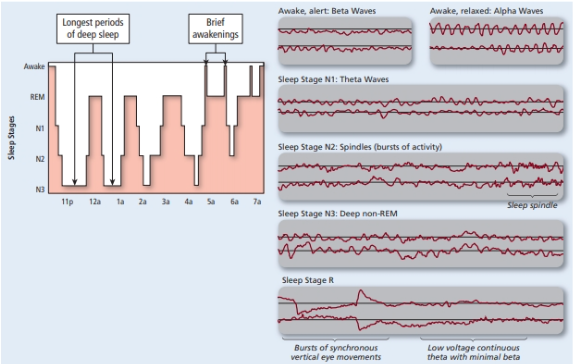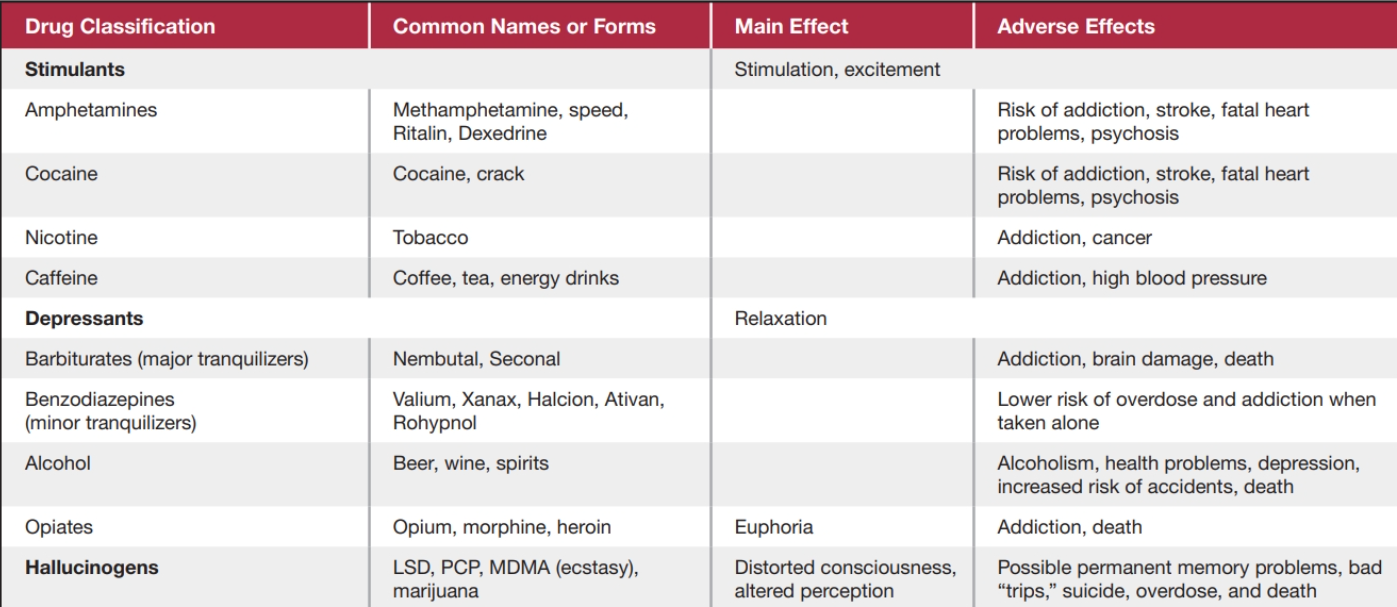Unit 3 - Consciousness
Consciousness: Awareness of everything going on outside and inside of you that organizes your behavior, including sensations, feelings, and thoughts.
Based on Daniel Dennett, consciousness works through multiple streams of consciousness rather than one, and consciousness organizes all conscious experiences based on social groups and cultures.
Altered State: Shift in quality or pattern of mental activity
Half conscious, not fully aware or in control
Circadian Rhythm: Your wake-sleep cycle, and it takes “about a day” (24 hours) for the cycle to be completed.
The sleep-wake cycle: The rise and fall of temperature and blood pressure, or the process of certain body chemicals.
Affects our hormone secretion
Pineal gland - In charge of secreting the hormone melatonin and is responsible for regulating patterns of waking and sleeping. Its major job is to take information about the environment’s status of the light-dark cycle and transmit it by producing and secreting the hormone melatonin.
Melatonin - Your brain releases the hormone melatonin due to the reaction to darkness. It aids in sleep as well as the timing of our circadian rhythms.
Hypothalamus: A tiny section of the brain influences the glandular system, produces melatonin
Explanation: The release of melatonin is influenced by a structure deep within the tiny hypothalamus in an area called the suprachiasmatic nucleus, the internal clock that tells people when to wake up and when to fall asleep. is sensitive to changes in light. As daylight fades, the SCN tells the pineal gland (located at the base of the brain) to secrete melatonin. As melatonin accumulates, it suppresses the neurons in the brain that keep us awake and alert, resulting in sleepiness. As the light coming into the eyes increases (as it does in the morning), the SCN tells the pineal gland to stop secreting melatonin, allowing the body to awaken. That’s a lot of control for such a small part of the brain.
The suprachiasmatic nucleus - part of the hypothalamus that controls the body temperature. The lower the temperature the sleepier a person is and the higher the temperature the more people are alert.
Controlled processes - require our conscious attention to a fairly high degree, such as driving, carrying on a conversation, or taking notes in your psychology class.
Automatic processes - require far less of a conscious level of attention—we are aware of these actions at a low level of conscious awareness; examples would be brushing one’s hair or well-practiced actions such as walking or riding a bicycle.
Necessity of sleep
Microsleep: Sleep lasting only for a few seconds, body starts over
Sleep deprivation: Sleep loss, impaired concentration and thinking ability, irritability
Sleep to recharge, if not enough, won’t function enough to do stuff
Why we sleep
Adaptive theory: Animals evolved patterns to avoid predators when predators are active
According to the adaptive theory, the reason why animals and humans have different sleep patterns is to avoid being in the presence of their predators during their hunting times which would be at night.
Restorative theory: Sleep is necessary for the physical health of the body, replenishes chemicals, and repairs cellular damage
Adaptive theory explains why people sleep when they do, and restorative theory (including the important function of memory formation) explains why people need to sleep.
People sleep because it is one of the human body's biological rhythms and it is a natural cycle of activity that the body needs to go through.
Factors that can influence the amount of sleep a person needs:
Light
Body temperature. (The suprachiasmatic nucleus, as part of the hypothalamus, controls body temperature. The higher the body temperature, the more alert people are; the lower the temperature, the sleepier they are. When people are asleep at night, their body temperature is at its lowest level)
Biological rhythm: Biological rhythm is the natural cycles of activity that our body must go through
Ex. the monthly cycle of a woman's menstruation
Ex. the heart's biological rhythm (where the cycle is short)
The recommended amount of sleep for most adults is 7-9 hours in 24 hours.
As we age, we sleep less until the average length of sleep is 6 hours.
Some reasons why older adults sleep less are because of the consequences of aging and more frequent trips to the bathroom, more snoring, and the changes in the brain’s reaction to light.
Sleep is also important for forming memories. Studies have shown that the physical changes in the brain that occur when we form memories are strengthened during sleep. Sleep may also reduce the activity of neurons associated with forgetting.
Babies sleep more because they need lots of energy to learn
For infants, sleep is to perchance to grow synapses.
Stages of sleep
Pre-sleep
Beta waves (smaller/faster): Wide awake, mentally active
Alpha waves (larger/slower): Relaxed, slightly sleeping
Non-Rem: Lighter stages to a much deeper, more restful kind of sleep
Stage 1: light sleep; hypnic jerk; hypnagogic images (about to fall from high building)
1-7 minutes
Theta waves increase as alpha waves decrease
Stage 2: The heart rate slows, body temperature drops, breathing more shallow and irregular
Sleep spindles (burst of energy, 1 or 2 sec): help stimulate neural areas in which recent memories have been stored, leading to better recall of those memories later on.
10-25 minutes
Theta waves
Stage 3 (&4): Growth hormones released; hard to wake up
20-40 minutes
Delta waves increase
Get shorter and shorter as the night progresses and would eventually be mostly REM sleep
Rem
Rapid eye movement: Eyes moving under eyelids. 90% of dreaming
10-60 minutes
Theta and delta waves
Near waking up
Dream more vivid
Sleep paralysis b/c muscles are paralyzed

Sleep disorders
Nightmare: Bad dreams arousing feelings of horror, helplessness, extreme sorrow (occur in any stage, mostly REM sleep)
Sleepwalking: Moving/walking around during sleep, stage 4 (non-rem)
Night terror: Attacks of extreme fear, might scream and flail (mostly based on trauma) (don’t wake them up)
Enuresis: Urinating while sleeping
Circadian rhythm disorders: Disturbances of the sleep-wake cycle such as jet lag and shift work
*The difference between nightmare and night terror is that in nightmares you vividly remember the dream upon waking up and don’t move around whereas in night terrors are the opposite
*Many sleep disorders are more common in boys than in girls because boys sleep more deeply than girls due to high levels of the male hormone testosterone.
Problems during sleeping
Insomnia: Inability to get to sleep, stay asleep, or get quality sleep (also sleeping often but still feeling tired)
Acute insomnia: Short-term (lasts days or weeks)
Chronic insomnia: Long-term (a month or more)
Sleep Apnea: Stops breathing for half a minute or more
Narcolepsy: Falls immediately into REM sleep w/o warning (usually you go through NREM sleep for an hour before changing to REM)
Cataplexy: Sudden loss of muscle
Uses sleep-walking for defense of murder:
Scott Falater Case: Drown wife while sleepwalking
Steven Steinberg Case: Stab wife 44 times, spend more time cleaning the pool
Kenneth Parks Case:
Dreams
Freud: Dreams as Wish Fulfillment
Manifest content (turning something or create something from an idea into a reality.)
Latent content (reasons behind the dream)
Activation-synthesis hypothesis: Dreass was created to explain brain stem activation during REM (w/o outside sensory information, brain sleep to explain why)
Activation-information mode model: Information accessed while awake affects your dream
(an updated version of ASH)
Fight with a friend, have a nightmare about it
Sleep paralysis
The inability of the voluntary muscles to move during REM
typically happen as a person is caught between REM sleep and waking up.
Some people have a rare disorder in which the brain mechanisms that normally inhibit the voluntary muscles fail, allowing the person to thrash around and even get up and act out nightmares. This disorder is called REM behavior disorder, which is a fairly serious condition.
Altered State: The Effects of Hypnosis
Hypnosis: State of consciousness where a person is especially susceptible to suggestion, frightened imagination
Four elements of hypnosis:
The person told to focus on what is being said
Told to relax and feel tired
Accept suggestion
Use vivid imagination
Hypnosis as an association: Works on immediate consciousness, while hidden “observer” aware of everything going on
Social-cognitive theory: Hypnotized people not in an altered state
hypnosis can and cannot list
Influence of psychoactive drug
Psychoactive drugs - chemical substances that alter thinking, perception, memory, or some combination of
those abilities perception, memory, or thinking
just look at the book Lamo
Major drug categories
- Depressants -Hallucinogens -Narcotics stimulants
Drugs increase the activity of the nervous system
Amphetamines - cause the nervous system to go into overdrive, stimulants that are made in laboratories rather than being found in nature.
Meth
Adderall
Benzedrine
Cocaine -
Nicotine - Vape, cigarettes
Caffeine
Depressants - Decreases the function of the nervous system
Barbiturates - drugs that have a sedative (sleep-inducing) effect
Benzodiazepines - Drugs used to lower anxiety and reduce stress
Alcohol
Stimulants: “Speed up” the nervous system—the heart may beat faster or the brain may work faster
Coffee
Cocaine
Nicotine (vaping) (increases the function of NS)
